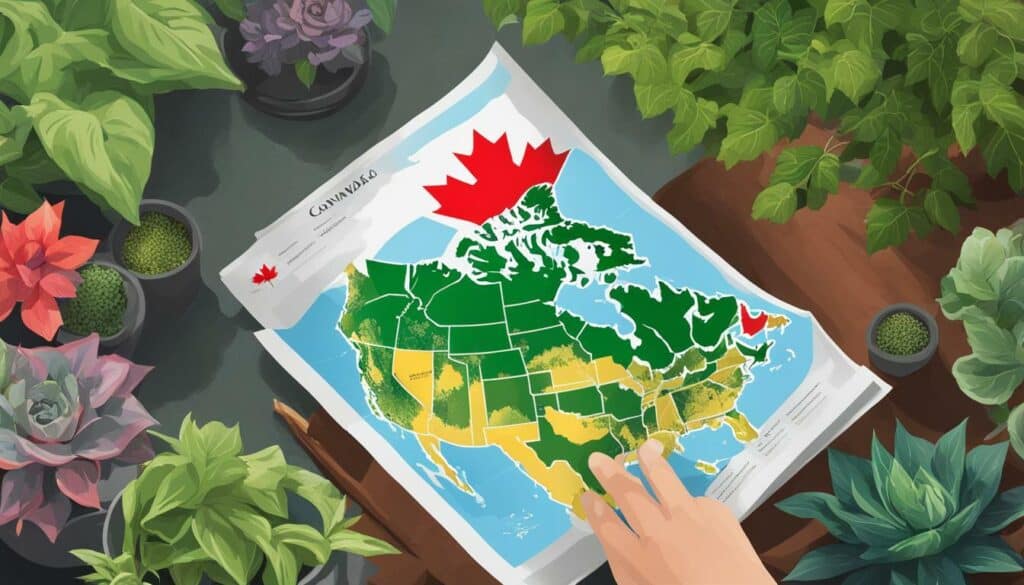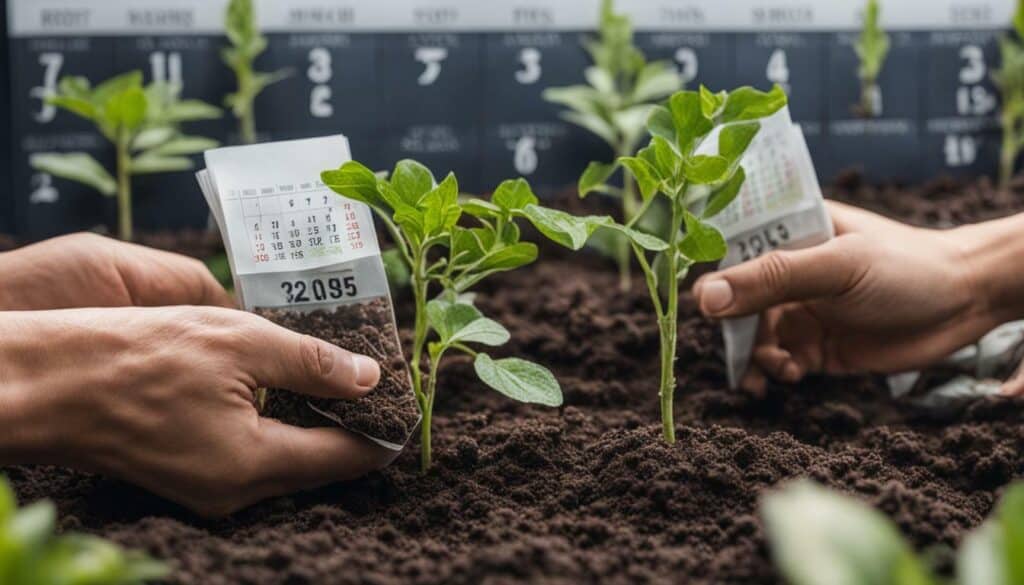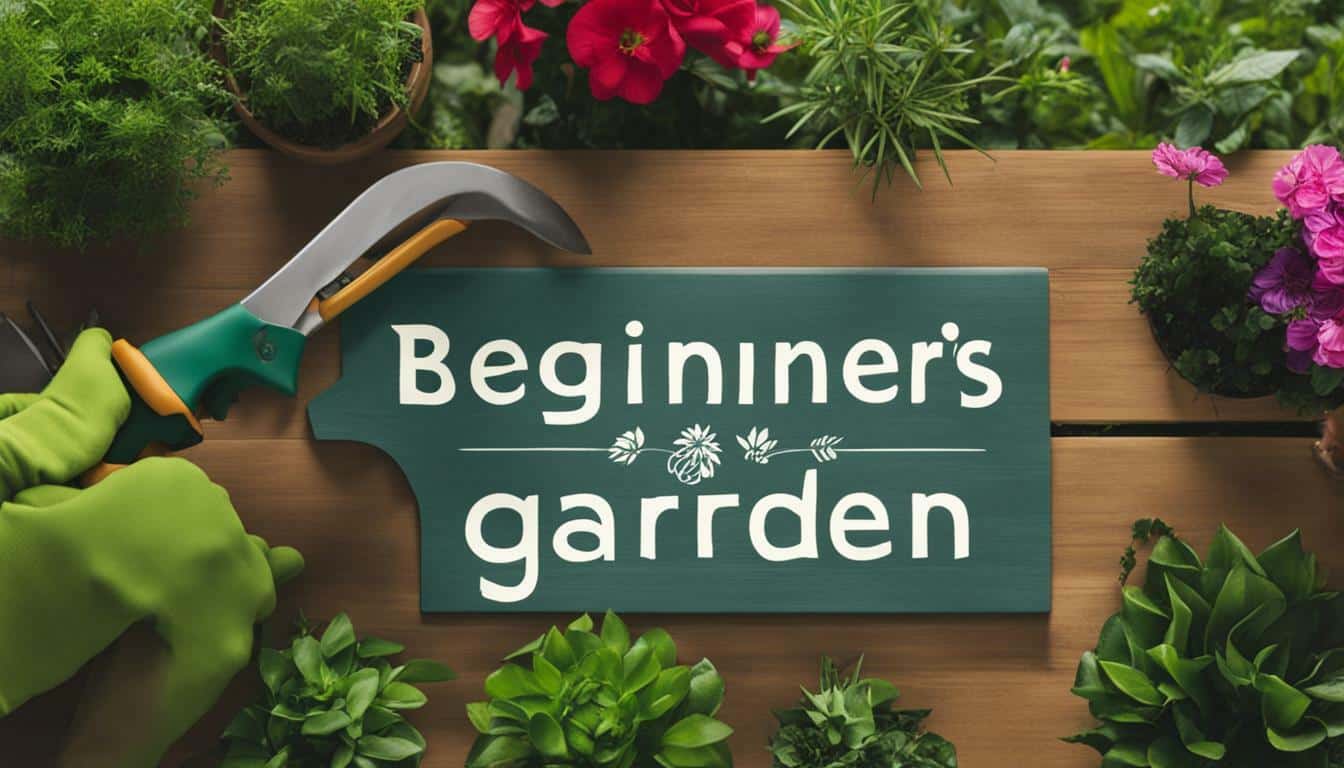Are you a beginner gardener in Canada looking to start your own green sanctuary? With these essential gardening tips, you’ll be well on your way to becoming a gardening pro! Gardening in Canada offers unique challenges and opportunities, and it’s important to learn the right techniques and practices to ensure the success of your garden.
Key Takeaways:
- Site your garden in a location that provides at least 6 hours of sunlight for optimal plant growth.
- Plan your garden near a water source for easy access to water your plants.
- Invest in nutrient-rich and well-drained soil, and consider using raised beds or containers for limited spaces.
- Choose plants that are suitable for your hardiness zone and growing conditions.
- Know your frost dates to avoid planting too early or late in the season.
Follow these tips to unlock your green thumb and enjoy successful gardening in Canada!
Starting Your Garden in the Right Location
One of the first steps in gardening is finding the perfect location for your garden in Canada. It’s crucial to consider factors like sunlight exposure and proximity to a water source. To ensure your plants thrive, they need a minimum of 6 hours of sunlight each day. Look for an area in your yard that receives ample sunlight, preferably in the morning or afternoon when it’s not too harsh. Remember that different plants have different sunlight requirements, so choose a location that suits the needs of the plants you intend to grow.
Another important aspect to consider when selecting the right location for your garden is the proximity to a water source. Your plants will need regular watering, especially during dry periods, so having access to water nearby will make it easier for you to provide the necessary moisture. Consider positioning your garden close to a water tap or install a rain barrel to collect rainwater. This will save you time and effort when it comes to watering your plants.
Remember, the success of your garden often depends on the environmental conditions it is exposed to. By choosing a location with sufficient sunlight and easy access to water, you are setting the foundation for a thriving garden in Canada.
Nurturing the Soil and Choosing the Right Containers
To create the ideal growing environment, pay attention to the quality of your soil and consider using raised beds or containers in your Canadian garden. Nutrient-rich and well-drained soil is essential for the health and vitality of your plants. You can test the pH level of your soil using a simple home testing kit available at most garden centers. Adjusting the pH level can ensure your plants receive the proper nutrients they need to thrive.
Raised beds and containers offer several advantages, especially if you have limited space or poor soil quality. They allow for better soil drainage and erosion control while providing a more controlled growing environment. With raised beds, you have the flexibility to create custom soil blends that cater to specific plant needs.
When choosing containers, ensure they have good drainage holes to prevent waterlogging. This will help prevent root rot and other moisture-related issues. Opt for containers made of durable materials such as plastic or clay. Plastic containers are lightweight and retain moisture better, while clay containers offer better insulation against temperature fluctuations.

| Benefits of Nurturing the Soil and Choosing the Right Containers: |
|---|
|
Remember, healthy soil is the foundation for a successful garden. By nurturing the soil and considering raised beds or containers, you’re ensuring a thriving growing environment for your plants. It’s time to dig in and unlock your green thumb!
Selecting Suitable Plants for Your Hardiness Zone
When starting a garden in Canada, it’s essential to select plants that can thrive in the specific hardiness zone of your region. Each zone has unique climatic conditions that determine which plants are most likely to succeed. To ensure the best chances of success, take the time to research and identify the hardiness zone of your area.
Consulting a hardiness zone map, such as the one provided by Agriculture Canada, can help you determine which plants are suitable for your zone. This will prevent you from wasting time and money on plants that are not likely to survive in your specific climate.
Additionally, consider the specific growing conditions of your garden, such as soil type, sunlight exposure, and moisture levels. Some plants may have specific requirements that should be taken into account for optimal growth. By selecting plants that are well-suited to your hardiness zone and growing conditions, you can create a thriving and beautiful garden.
Hardiness Zone Chart for Canada
| Zone | Temperature Range (°F) |
|---|---|
| Zone 0 | -60 to -50 |
| Zone 1 | -50 to -45 |
| Zone 2 | -45 to -40 |
| Zone 3 | -40 to -35 |
| Zone 4 | -35 to -30 |
| Zone 5 | -30 to -20 |
| Zone 6 | -20 to -10 |
| Zone 7 | -10 to 0 |
| Zone 8 | 0 to 10 |
| Zone 9 | 10 to 20 |
| Zone 10 | 20 to 30 |
| Zone 11 | 30 to 40 |

Referencing this hardiness zone chart will help you make informed decisions when selecting plants for your garden. It provides a clear overview of the temperature range associated with each zone, allowing you to choose plants that can tolerate the conditions in your area.
Remember, gardening success depends on selecting the right plants for your hardiness zone. By doing so, you’ll create a thriving garden that brings beauty, joy, and fresh produce to your home in Canada.
Timing Your Planting with Frost Dates
One of the key factors in successful gardening in Canada is understanding the frost dates and planting accordingly. Frost dates vary across the country, and planting too early or late can result in damage or stunted growth for your plants. To ensure the best chance of success, it’s important to know the last expected frost date in the spring and the first expected frost date in the fall for your specific location.
By consulting a frost date chart or contacting your local gardening center, you can determine the most favorable time to start planting in your area. This will help you avoid the risk of frost damaging your tender seedlings or young plants. It’s recommended to wait until after the last frost date to plant warm-season crops such as tomatoes and peppers, as they are particularly sensitive to cold temperatures.
Additionally, knowing the first expected fall frost date will help you plan your late-season crops and ensure they have adequate time to mature before the cold weather arrives. Some plants, like certain varieties of lettuce and kale, actually benefit from cooler temperatures and can be planted as late as mid-summer for a fall harvest.

Understanding and following the frost dates for your area is an essential step in successful gardening in Canada. It will help you make informed decisions about when to plant and protect your plants from potentially damaging frost. So mark your calendar, plan accordingly, and watch your garden thrive!
Mulching for Weed Control and Moisture Conservation
An effective gardening tip for beginners in Canada is to use mulch around your plants to minimize weed growth and retain moisture. Mulch acts as a protective layer on the soil surface, preventing weed seeds from germinating and competing with your plants for nutrients and sunlight. It also helps to reduce soil erosion and conserve moisture, especially during hot summer months.
There are various types of mulch you can use in your garden, such as wood chips, straw, leaves, or even grass clippings. Choose a mulch that is suitable for your plant’s needs and the conditions in your garden.
When applying mulch, make sure to spread it evenly around your plants, leaving a small gap around the stem to prevent moisture-related diseases. Aim for a thickness of 2-4 inches, as this will provide effective weed control and moisture conservation. However, be cautious not to pile mulch against the trunk or stems of your plants, as this can create a damp environment and promote rot.
The Benefits of Mulching:
- Suppresses weed growth by blocking sunlight and preventing weed seeds from germinating.
- Conserves moisture by reducing evaporation and maintaining soil moisture levels, especially during dry periods.
- Insulates the soil, protecting plant roots from extreme temperatures.
- Improves soil fertility over time as the mulch decomposes, adding organic matter to the soil.
- Reduces the need for frequent watering and manual weeding, saving you time and effort in your garden.
By incorporating mulching into your gardening routine, you’ll create a healthier and more productive garden in Canada. So, grab your mulch of choice and get ready to enjoy the benefits of weed control and moisture conservation in your garden.

Feeding Your Plants for Optimal Growth
To ensure your plants thrive, it’s crucial to provide them with the necessary nutrients through regular feeding with high-quality plant food. Just like humans, plants need a balanced diet to grow strong and healthy. By understanding the nutritional needs of your plants and implementing a feeding schedule, you can promote optimal growth and maximize your gardening success.
One important aspect of plant nutrition is understanding the key nutrients that plants require. These include macronutrients such as nitrogen (N), phosphorus (P), and potassium (K), as well as micronutrients like calcium, magnesium, and iron. Each nutrient plays a vital role in various plant functions, from leaf development to flower production.
When choosing plant food, look for a balanced formula that contains all the essential nutrients your plants need. Organic options, such as compost or well-rotted manure, can provide a natural and slow-release source of nutrients. Alternatively, synthetic fertilizers are designed to deliver nutrients in a more concentrated and readily available form.
Remember to follow the instructions on the packaging when applying plant food. Overfeeding can lead to nutrient imbalances and potential damage to your plants. Additionally, consider supplementing your feeding routine with foliar sprays, which allow plants to absorb nutrients through their leaves, providing a quick boost when needed.
Feeding Schedule
To establish a feeding schedule, assess your plants’ needs throughout the growing season. Young plants may require more frequent feedings to support their rapid growth, while established plants may benefit from a lighter feeding schedule.
As a general guideline, feed your plants every two to four weeks during the active growing season. However, remember to adjust this schedule based on your plants’ specific needs, as well as factors such as weather conditions and soil fertility. Regularly monitor your plants for signs of nutrient deficiencies or excesses, such as yellowing leaves or stunted growth, and make adjustments accordingly.
| Plant | Feeding Schedule |
|---|---|
| Vegetables and herbs | Every two weeks |
| Flowering annuals | Every three weeks |
| Perennials | Every four weeks |
| Fruit trees and shrubs | Early spring and late fall |
By following a feeding schedule and providing your plants with the necessary nutrients, you can ensure they receive the support and nourishment they need to thrive. Remember, each plant is unique, so observe and adjust your feeding routine accordingly. With proper feeding, your plants will grow vigorously, producing beautiful blooms, abundant foliage, and delicious harvests.
Essential Gardening Tools for Beginners
As a beginner gardener in Canada, it’s important to have the right tools to make your gardening experience more enjoyable and efficient. Whether you have a large backyard or a small balcony, having the essential gardening tools will help you get started and maintain your garden with ease.
Here are some must-have tools that every beginner gardener should have in their arsenal:
- Hand Trowel: This small tool is perfect for planting small flowers, transplanting seedlings, and digging small holes. It’s a versatile tool that you’ll find yourself using frequently.
- Gardening Gloves: Protect your hands from dirt, thorns, and sharp objects with a good pair of gardening gloves. Look for gloves that are durable, comfortable, and provide a good grip.
- Pruning Shears: Keep your plants well-maintained with a pair of pruning shears. Use them to trim dead or damaged branches, shape your plants, and harvest herbs and flowers.
- Watering Can: A watering can is essential for keeping your plants hydrated. Choose one with a comfortable handle and a long spout for easy pouring.
- Garden Fork: A garden fork is useful for turning soil, breaking up clumps, and removing weeds. It’s especially handy for preparing your garden bed before planting.

These are just a few basic tools to get you started on your gardening journey. As you gain experience and expand your garden, you can invest in additional tools like a garden rake, a garden hose with a spray nozzle, and a wheelbarrow for transporting heavy items.
Remember to clean and maintain your tools regularly to ensure their longevity. Keep them organized in a shed or a tool rack for easy access. With the right tools and a little bit of patience, you’ll be well on your way to creating a beautiful and thriving garden in Canada!
Table: Essential Gardening Tools for Beginners
| Tool | Function |
|---|---|
| Hand Trowel | Planting, transplanting, digging small holes |
| Gardening Gloves | Hand protection from dirt, thorns, and sharp objects |
| Pruning Shears | Trimming, shaping, and harvesting |
| Watering Can | Watering plants |
| Garden Fork | Turning soil, breaking up clumps, removing weeds |
Conclusion
By following these essential gardening tips for beginners in Canada, you’ll be on your way to creating a beautiful and thriving garden. Site your garden in a location that provides at least 6 hours of sunlight and plan it near a water source for easy watering. Invest in nutrient-rich and well-drained soil, and consider raised beds or containers for limited spaces. Choose plants suitable for your hardiness zone and be mindful of frost dates when planting. Use mulch to reduce weeds and conserve moisture, and regularly feed your plants with high-quality plant food for optimal growth. And don’t forget to start with basic gardening tools to make your gardening experience easier.
With these tips in mind, you’ll be able to unlock your green thumb and enjoy a successful gardening journey in Canada. Whether you’re just starting out or looking to enhance your gardening skills, these tips will set you on the right path. Gardening is not only a rewarding hobby but also a great way to connect with nature and enjoy the beauty of your own green space. So roll up your sleeves and get ready to watch your garden thrive!
What Is the Best Soil for Beginner Gardeners in Canada?
When starting a garden in Canada, choosing the best soil for beginner gardeners is crucial. A nutrient-rich blend, such as loamy soil, is ideal for supporting plant growth. It retains moisture while allowing proper drainage, which helps prevent root rot. Beginners should also consider adding organic matter, like compost, to further enrich the soil and promote healthy plant growth.
FAQ
Q: Where should I site my garden?
A: You should site your garden in a location that you’ll see regularly, providing at least 6 hours of sunlight for your plants to thrive.
Q: Should I plan my garden near a water source?
A: Yes, it is recommended to plan your garden near a water source to easily water your plants when needed.
Q: What kind of soil should I invest in?
A: You should invest in nutrient-rich and well-drained soil for your garden. Consider using raised beds or containers for limited spaces.
Q: How do I choose plants for my garden?
A: Choose plants that match your growing conditions and are suitable for your hardiness zone.
Q: How do I avoid planting too early or late in the season?
A: Know your frost dates to avoid planting too early or late in the season.
Q: Should I use mulch around my plants?
A: Yes, using mulch around plants can reduce weeds and conserve moisture.
Q: How often should I feed my plants?
A: Feed your plants regularly with high-quality plant food for optimal growth.
Q: What basic gardening tools should I start with?
A: Start with basic gardening tools to make your gardening experience easier.
Q: How can I unlock my green thumb for successful gardening in Canada?
A: Follow these tips to unlock your green thumb and enjoy successful gardening in Canada!





Leave a Reply